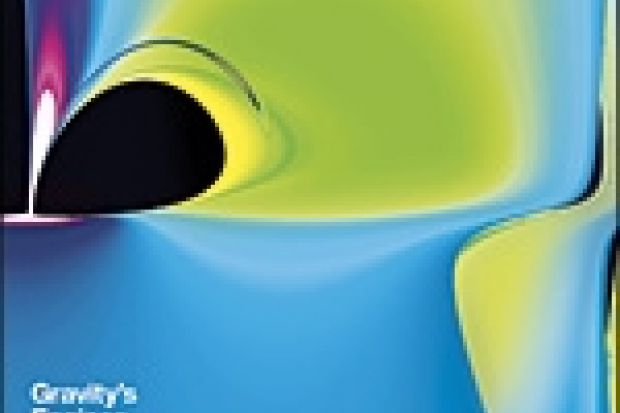Black holes generally appear in the non-technical literature as swallowing irretrievably anything that comes too close, whether that is stars, gas, light or tiresome in-laws. This is perfectly true (well, the in-law case hasn’t been tested). Caleb Scharf has, however, chosen to focus on what the stuff - generally by then gas in a disc rotating around a central black hole - does just before disappearing. First, it gets hot enough to radiate not just visible light but copious X-rays. Second, if there are magnetic fields around to be tangled by the rotation, the disc will collimate outgoing, very fast (relativistic, we say in the business) jets, which carry away some of the gas perpendicular to the disc, blowing bubbles in, and compressing, whatever might be around and radiating the radio waves that originally led to the discovery of excitement at the centre of galaxies.
Scharf’s main point is that the action of supermassive black holes in galactic nuclei during formation and subsequent evolution has played a large role in shaping the galaxies and regulating the formation of stars. Because galaxies host stars, which in turn host planets and fuse hydrogen and helium into other elements that we need, including carbon, nitrogen and oxygen, the author concludes that black holes play a vital role in the origin of life. To get there, he necessarily covers a large fraction of astronomy and cosmology.
There are things to cheer in this book: the first real discussion of the first person to write about objects whose gravity could trap light, geology professor and clergyman John Mitchell (1724-1793); the neat fact that the number of microwave background photons in the volume of the solar system at present is about the same as the number of protons and other subatomic particles. My favourite is a travelogue in which the reader accompanies photons from their start long, long ago in a galaxy far, far away to their arrival at the Chandra X-ray Observatory orbiting Earth. Time and distance are represented by what was happening on Earth during the last 4.5 billion years of the journey. En route, “two billion years later, the photons enter… regions with the great superclusters… of galaxies. On earth, microbial evolution has just given rise to the first cells of a new type of life, the Eukarya”; and close to arrival, “the photons begin to pass through the collection of stars that forms the constellation of Auriga… The Vietnam war is flaring, and the Beatles are playing on every radio…”
But this is not the whole story. Perhaps it was bad luck that the first page I happened to read was wrong, both about why the sky is dark at night and who first asked the question. It is called Olbers’ Paradox after German astronomer Heinrich Wilhelm Olbers, but Thomas Digges, Edmond Halley, Johannes Kepler and Jean Philippe Loys De Cheseaux thought about the issue centuries before him. As for the cause, it is neither the age of the Universe nor its expansion, but its energy content. In 100 randomly distributed pages of counting, I flagged 20 flat “No”s and 69 less assertive reservations (misleading analogies, incomplete credits, slippages that one might label “um”, “oops” and “well”). Here’s a typical “oops”: “2.3 mile tubes in which lasers bounce back and forth” (this would be really hard on the lasers, and it is actually only their light that bounces). An “oh?” is the statement that humans have been drawing or carving maps for more than 10,000 years. And an “incomplete credit” mentions Karl Jansky, who first observed non-terrestrial radio radiation, but not the second radio astronomer, Grote Reber, who found the first source that turned out to be a giant black hole in a nearby galaxy (Cygnus A).
The “?”s I flagged while reading mean “perhaps”, but I would want to check the calculations myself, eg, the statement that our Sun will engulf all the inner planets when it becomes a red giant (Mercury and Venus yes, Earth possibly, Mars probably not). And why should the red giant Sun be “gouty”? Yes, the outer layers will contain carbon, nitrogen and oxygen, some from its own nuclear reactions, as well as hydrogen, but assemblage as C5H4N4O3 is most unlikely (an inappropriate analogy).
Clearly we who are paid to do astronomy and/or history of science are not the right audience for Scharf’s book. Sadly, neither are our students. The large number of items requiring correction or qualification would swamp classroom hours. I will be teaching a seminar on black holes for non-science students next term, but the text will not be Gravity’s Engines.
Gravity’s Engines: The Other Side of Black Holes
By Caleb Scharf
Allen Lane, 2pp, £20.00
ISBN 9781846145339
Published 1 November 2012
Register to continue
Why register?
- Registration is free and only takes a moment
- Once registered, you can read 3 articles a month
- Sign up for our newsletter
Subscribe
Or subscribe for unlimited access to:
- Unlimited access to news, views, insights & reviews
- Digital editions
- Digital access to THE’s university and college rankings analysis
Already registered or a current subscriber? Login




